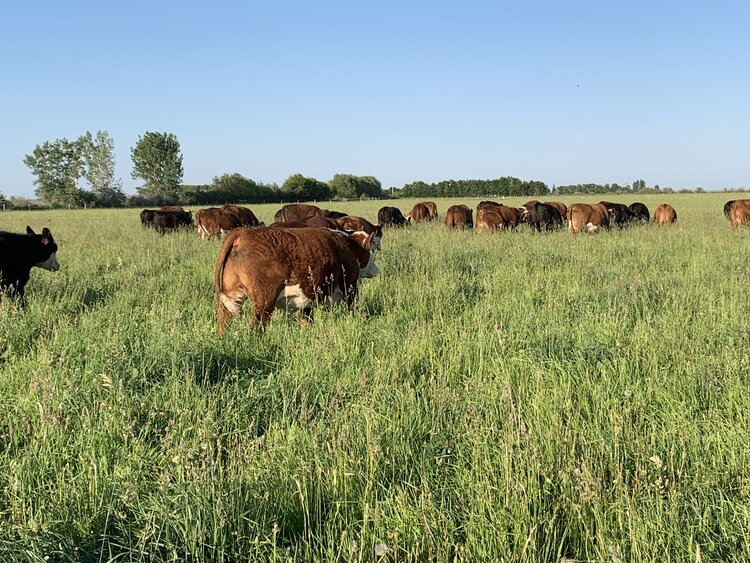One of the most common questions from our customers is: “How do you raise grass finished beef in the winter?” After all, there isn’t any grass growing in the winter in Alberta. Before we started our farm to table company we wanted to know the same thing. We spent lots of time learning from some of the “gurus” of the grass finished beef from around the world. Can you produce authentic high quality grass fed beef in a cold climate? The answer is yes you can, and there are even some advantages of grass finishing in a cold climate. In this blog we will describe how we raise our cattle in a cold climate.

This is what it looks like in the spring, summer and early half of fall. We graze the cattle on perennial pastures, moving them every day to keep them growing and make sure they eat only the top half of the plants or less.
In the spring, summer and fall our cattle graze on lush green pastures with a variety of grass species including brome, orchard grass, rye grass, clover, alfalfa and vetch. We use rotational grazing on these pastures. The cattle are moved every day to ensure they are always eating the most nutritious part of the plant. But what about winter?
In addition to pastures we also have farmland that we use to grow a variety of crops including alfalfa, cereals and rye grass. Some of these crops are harvested from the field and fed to the cattle during the winter. Sometimes we leave the crop in the field in swaths and let the cattle graze the crop in the winter. By harvesting highly nutritious crops during the growing season we can preserve quality feed for the cattle in the off season. Even in the winter they remain out in open fields. To help protect against the cold we spread straw so they have thermal layer to sleep on.
Did you know that even in the warmer regions of the world grass fed cattle may still need to be fed harvested forage? In hot dry climates like the southern parts of the USA, pastures can get so hot and dry that the nutritional quality of the grass decreases significantly. Hay is grown in the cool season and harvested so they can supplement the cattle with forage in the dry season. A lot like what we have to do in the winter…just the other way around! Because of our cool nights in the summer we are able to produce very nutrient dense pastures and forage crops that can be grazed or harvested for winter feeding. This is one advantage of a cool climate like ours.
Here is a brief description of some of the traditional and regenerative methods we use for winter feeding.
Making hay while the sun shines:
We grow alfalfa for hay. The alfalfa is cut with a swather at least twice in the summer. After a few days in the sun when the hay has cured it is baled. Rain can be a problem so we are always watching the weather and hope to get it baled without any rain. The bales can be rolled out in the winter for the cows. Usually we feed out on dormant pasture. The cattle will continue to graze older plant material from the pasture along with the hay that we provide.

Yearling Steers and Heifers eating hay.
Swath Grazing:
Each year we grow some crops for swath grazing. In fall the crop is swathed and the swaths are left in the field. When it gets cold and the ground is frozen we move the cows out to the swaths. They can easily dig through snow to find the plants in the swath still green and nutritious. Temporary fencing is used to limit the area of the field that they can access at one time. Similar to the rotational grazing that we do in the summer. This is a lower cost method as there is less need for equipment and the cows do more of the work! It also helps regenerate the land by leaving manure distributed evenly across the fields.

Yearlings grazing on clover and corn swaths. The corn is a special variety grown specifically for grazing rather than harvesting the corn. The goal is to swath before the cobs are formed. This picture was taken in late fall when the summer pastures have stopped growing. No snow yet!
Silage
Silage is a type of feed made from green foliage that is chopped up and preserved. We grow a crop like barley, wheat or alfalfa in the summer. In late summer before the plants have matured and made seed we cut and harvest the crop with a chopper. The chopped forage is piled, packed with a tractor and covered up to make it airtight. Over time it ferments, making a more stable nutrient dense forage called silage. Kind of like canning pickles! Silage is typically much more nutritious and palatable than cured feed. Because it has so many nutrients and more energy it is very good for high quality beef production. This method is more labor intensive and costly, but it is a very good way to preserve high quality feed and the same land is typically used for grazing later in the year.

This is an example of a crop we harvested for silage. It has a diversity of plants growing to improve soil health. The crop is swathed before the seeds fully develop.

This is what the forage crop above looks like when it has fermented into silage. We feed this in the winter along with hay and supplements.
Supplements
We use a minimal amount of supplemental ingredients in the winter only. In the cold months it is important to make sure our cattle are growing and gaining to produce high quality nutrient dense beef. Supplements can help make sure we achieve this. Our supplement program includes a small amount of natural minerals for optimal health, flax meal (high in omega 3’s), and malt sprouts for additional energy. These supplements make up a very small percentage of the diet throughout the winter.
We do not feed any grains like corn or barley to our grass fed cattle ever.
A Unique eating experience
We hope this helps explain how we do grass finished beef in a cold climate on our farm. Our goal throughout the year is to produce high quality grass finished beef that is tender, nutrient dense, well marbled and most importantly flavorful! We believe the combination of soils, pastures, crops, cattle genetics and management are unique to our farm. Round it off with a passion for grass fed beef production and you get a unique local eating experience. Try the flavor of our farm, we hope you enjoy it!
Any Questions? Please contact us we love to talk beef!
Let's Connect!
Follow us on Facebook, Twitter and Instagram
Subscribe to our newsletter to stay up-to-date with all of our pro tips, recipes, and upcoming events!

